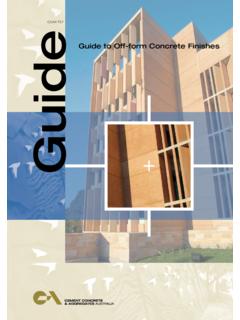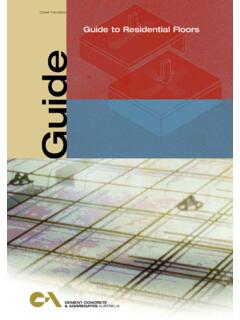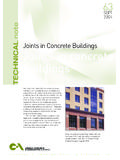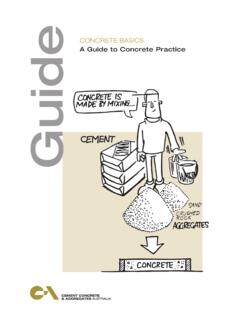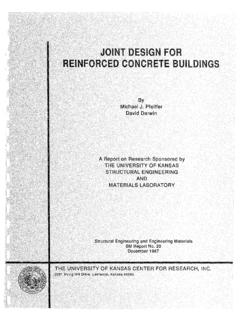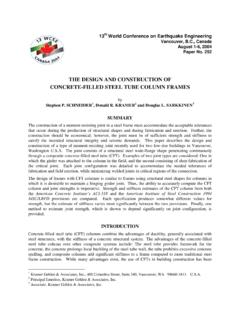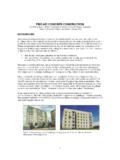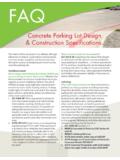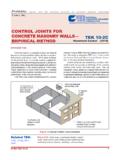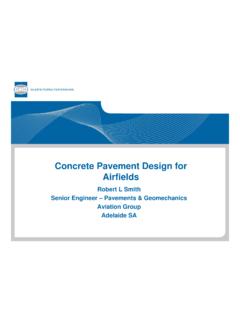Transcription of Joints in Concrete Buildings - CCAA
1 63. SEPT. 2004. TECHNICAL note Joints in Concrete Buildings Joints in Concrete Buildings Any joint , as in a physical break or gap between members, in a Concrete structure or building is a potential weak link which may lead to serviceability problems, lack of durability or structural failure. Yet seldom, if ever, is a building constructed without them. In many situations they are necessary requirement (eg to accommodate anticipated differential movement between members) and are sometimes regarded as a necessary evil. Frequently, problems arise because they are given insufficient attention by designers both in terms of their location and detail design. This Technical Note reminds designers of the reasons for including Joints in Buildings and the performance requirements they should meet. It gives some guidance on their planning, design and detailing and provides examples of Joints which have performed satisfactorily.
2 Panel-to-panel Joints and false Joints articulate the cream GRC cladding and the reconstituted granite podium cladding at St George Private Medical Complex Kogarah NSW. Top of floor DEFINITION. The word joint ' is used in building parlance to cover elements which have to perform quite different Beam soffit Scabble and clean laitence off surface functions, eg beam-column Joints and isolation prior to placing Longitudinal column Joints . In the former the joint has to provide continuity reinforcement beam reinforcement of structural action between the members meeting at the joint . In the latter the joint has to ensure separation between the adjacent members to allow Figure 1. one member to move independently of the other. This Technical Note deals primarily with Stop-board to form joint isolation Joints and tends to use Joints ' in this sense. However, a discussion of construction Joints is included because they are frequently referred to in D.
3 Insitu Concrete construction . There are a number of ways in which Joints can be classified apart from the broad division stated above. In this Technical Note a limited number of specific Joints defined by their situation are Figure 2. considered. WHY Joints ARE NEEDED Planned construction Joints The location and The four basic reasons for requiring Joints are detailing of planned construction Joints can be because considered and prepared. The location should be the member or structure cannot be constructed determined in conjunction with the contractor. The as a monolithic unit in one placement of contractor will be able to define the maximum size Concrete ; of Concrete placement possible on the particular the member has to be of limited size so it can project taking into account the anticipated rate of be handled by cranes, etc; placement and the constraints imposed by finishing the structure or member on one side of the joint requirements.
4 Where possible, the day's placement needs to be able to move relative to that on the should terminate to coincide with other Joints in the other; structure. the design assumptions for the structure or construction Joints should be on a single plane building need the joint at that point so the and preferably located at right angles to the main analysis is simplified. reinforcement. They should preferably be vertical or There is a major difference in the objectives and horizontal to the member. Keys are sometimes requirements for Joints constructed for the first included but these can lead to difficulties in reason ( construction Joints ) compared to the third stripping. If possible, they should be positioned (isolation Joints ) as already noted. This Technical away from regions of high shear or high moment. Note does not address Joints required for design AS 36002 requires that in columns and walls a reasons.
5 construction joint be formed logically at the soffit of the beams and slabs they support Figure 1. During construction Joints placement the Concrete adjacent to the joint should A construction joint is defined by the ACI1 as the be well compacted and special attention should be surface where two successive placements of paid to vibration. The joint should be stripped when Concrete meet, across which it may be desirable to the Concrete has set and hosed down to expose the achieve bond and through which reinforcement may coarse aggregate. Any problems in stripping of the be continuous'. Generally, because continuity of joint will be eased if it is located away from regions structural action will be required across the joint , of high moment and reinforcement congestion. bond will be desirable and the reinforcement will be Immediately prior to placing Concrete in the next continuous.
6 Section, the surface should be coated with a cement construction Joints may be either planned or slurry. unplanned. Typical details for a construction joint in a Concrete pavement or industrial floor on grade are shown in Figure 2. The slab reinforcement is carried through the joint and extra tie bars are inserted to hold the two sides together. Page 2 Joints in Concrete Buildings Sealant Filler Unplanned construction Joints These are Joints that are forced upon the Concrete -placing crew because of an interruption in supply of a duration Abutting structure long enough for the Concrete to take its initial set. There is no opportunity to plan their location. Figure 3. Principles to follow can be only indicated. As with planned Joints , the Concrete should be cut back to broadly approximately a single plane and the face It suggests that the required properties of a joint made vertical.
7 Top ends should be used where sealant are that it: possible and the Concrete vibrated against these. be impermeable material;. After forming and clearing the excess Concrete deform to accommodate the movement and rate away, the joint should be treated as for planned of movement occurring at the joint ;. construction Joints . sufficiently retain its original properties and shape if subjected to cyclical deformations;. joint REQUIREMENTS adhere to Concrete . Designers and specifiers of Joints should have a In general, field-moulded sealants suitable for clear understanding of the specific requirements for face sealing Joints between precast wall cladding any joint on a specific project. These will range from panels will be either polysulphides, polyurethanes weathertightness to ease of maintenance and repair, or silicone. and will be discussed under each specific joint type.
8 To minimise the strain on the sealant as the However, there are a few aspects which warrant joint opens or closes, a rectangular cross section discussion before looking at the specific joint types: with a larger width than depth across the joint is Buildability and minimum size Designers preferred. The use of backup materials to control should be confident that the chosen detail can the depth of sealant is therefore recommended. be easily fabricated and will permit easy and safe construction . Proven details should be PAVEMENT-ABUTTING STRUCTURE ISOLATION. reused where appropriate; reinvention of the joint . wheel should be avoided. Joints must be wide Description A joint occurring where a pavement, enough to accommodate the tolerances of (ground-supported floor) abutts a structure; it fabrication, construction and erection. This allows the pavement and adjacent structure to usually means a minimum width of 20 mm.
9 Move relative to each other Figure 3. Maintenance and repair As noted earlier, Joints are the focal point for wear and deterioration; Requirements The joint should not impede any aspects of maintenance and repair should be relative movement. This may be horizontal, vertical considered at the design stage. The choice of a or both and may include rotation. Concrete drying suitable sealant is important as is the appropriate shrinkage in the pavement will mean the joint will sealant cross-section. Although today's sealants usually open with time. However, temperature are long-lasting, they eventually will need changes and prestressing forces may give rise to replacement or repair; the process and ease of joint closing movements. The Joints should be this should be part-and-parcel of joint design. sealed to prevent ingress of detritus which may There should be provision for inspection and inhibit this movement.
10 Ability to resist positive water maintenance of face sealants. Locating pressure is not usually required; if it is required, downpipes in front of a face-sealed joint , whilst reference should be made to Joints for water- protecting the sealant from UV light, impedes retaining structures. both inspection and repair. Sealants These are proprietary products and the construction The filler material and sealant should advice on particular products should be obtained be capable of accepting the required expansion and from the particular manufacturer/supplier, offer little resistance to any compression. The faces eg on cross-section dimensions for the sealant should be well compacted during construction to and precautions to be taken during installation. give a smooth finish which offers little resistance to However, the ACI Guide to Sealing Joints in vertical movement.
